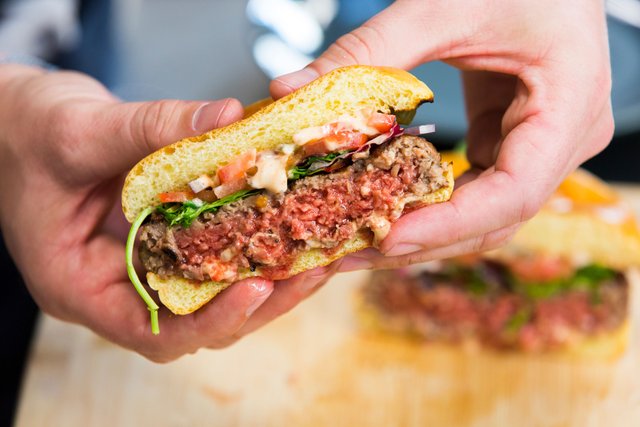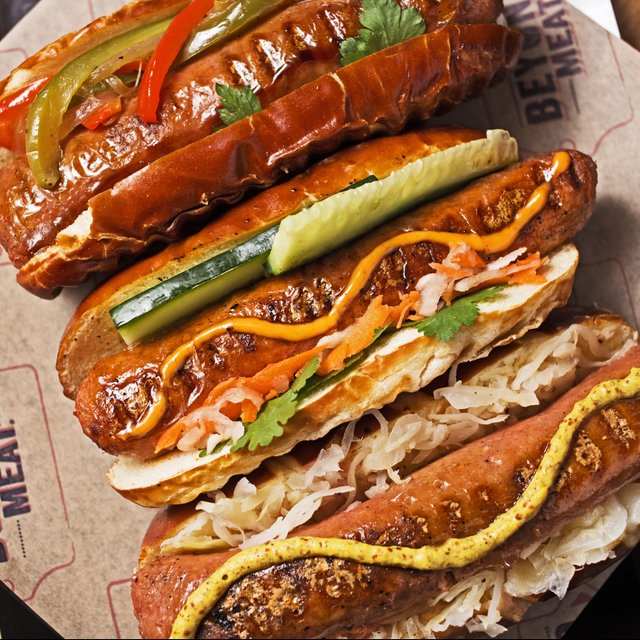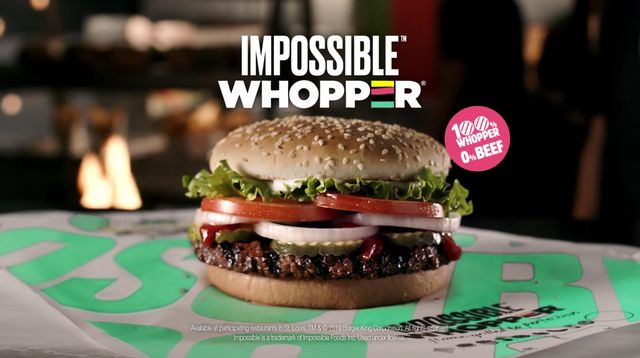A guide to the two hottest faux meat products
Undoubtedly 2019 is the year of faux meat.
With Beyond Meat going public -- and shocking people all over with a better-than-expected IPO -- fake meat stands a chance to become a huge industry of its own, larger than just a part of the plant-based movement.
For various reasons, such as personal health concerns and the environmental impact of animal agriculture, more people are choosing to eat less meat. But with new brands cropping up across the market, consumers are faced with more decisions than ever before.
Here's your guide to two of the most popular faux meat options on the market: the Impossible Burger from Impossible Foods and the Beyond Burger from Beyond Meat.
Comparing ingredients
Look at the packaging on a Beyond Burger or an Impossible Burger and you'll find a sprawling list of ingredients.

The Impossible Burger contains:
Water, Soy Protein Concentrate, Coconut Oil, Sunflower Oil, Natural Flavors, 2% or less of: Potato Protein, Methylcellulose, Yeast Extract, Cultured Dextrose, Food Starch Modified, Soy Leghemoglobin, Salt, Soy Protein Isolate, Mixed Tocopherols (Vitamin E), Zinc Gluconate, Thiamine Hydrochloride (Vitamin B1), Sodium Ascorbate (Vitamin C), Niacin, Pyridoxine Hydrochloride (Vitamin B6), Riboflavin (Vitamin B2), Vitamin B12.
Other than water, the main ingredient is soy protein concentrate. In and of themselves, soybeans are perfectly healthy, but soy protein concentrate is heavily processed, which means many of the benefits of the raw food are lost.

For example, raw soybeans provide a great deal of calcium, vitamin C, vitamin B-6, iron and magnesium, but Impossible Foods fortifies its burgers with vitamins and minerals, likely to make up for the lost nutrients during processing.

The Beyond Meat Burger
The Beyond Burger contains:
Water, Pea Protein Isolate, Expeller-Pressed Canola Oil, Refined Coconut Oil, Contains 2% or less of the following: Cellulose from Bamboo, Methylcellulose, Potato Starch, Natural Flavor, Maltodextrin, Yeast Extract, Salt, Sunflower Oil, Vegetable Glycerin, Dried Yeast, Gum Arabic, Citrus Extract (to protect quality), Ascorbic Acid (to maintain color), Beet Juice Extract (for color), Acetic Acid, Succinic Acid, Modified Food Starch, Annatto (for color).
In terms of ingredients, the two burgers are pretty similar, the exception being the main protein source. Beyond Meat uses pea protein instead of soy protein, and there's no soy leghemoglobin, which is Impossible's key ingredient that makes the burger "bleed."
Also, Beyond Burger's red color comes from beet extract, rather than heme from the leghemoglobin like in the Impossible patty.
Are they vegan?
Yep, the Impossible Burger and Beyond Meat Burger are both vegan -- neither contains any animal products of by-products.
In a statement to CNET, Impossible Foods confirmed that its burger is vegan, but noted it has used animal testing to evaluate the safety of its heme protein (also called soy leghemoglobin).
Beyond Meat goes one step further to state that all of its products are certified vegan by the Vegan Action Foundation.
The Impossible Burger is also certified halal and kosher. Beyond Meat doesn't specify if its products are kosher or halal.
Is one healthier than the other?
The bottom line is that both of these companies have created a "burger" in a lab, made from only plant products and designed to emulate the taste and texture of real beef. Your comfort level with that depends on your stance on food engineering (and how picky you are about beef, if you do eat it).

Beyond Meat offers sausages and "beef" crumbles in addition to the Beyond Burger.
A few things might influence your opinion on which burger is healthier:
The Impossible Burger contains mostly organic ingredients, while the Beyond Burger doesn't
The Beyond Burger is strictly non-GMO, whereas Impossible Foods recently faced backlash about using genetically modified ingredients that contain the pesticide glyphosate
The Impossible Burger is fortified with more vitamins and minerals than the Beyond Burger
From a numbers standpoint, both burgers hit around the same marks: Per serving they both have:
Just under 300 calories
About 20 grams of protein
Nearly 400 milligrams of sodium -- so be mindful if you're watching your salt intake.
The Beyond Meat burger has 20 grams of fat to Impossible Burger's 14. You can see the full nutritional values for the Impossible Burger and Beyond Meat for more info.

How do they taste?
Well, the Impossible Burger evidently tastes enough like real beef to gross out vegetarians, and food scientists at Impossible Foods say the burger can substitute for ground beef in any recipe.
The Beyond Burger is described as having a somewhat coconut-y aftertaste, but the majority of reviews on Amazon come from happy customers who are impressed by proximity to real beef.
Both burgers are generally described as resembling beef more than traditional veggie burger patties (like a Boca Burger). However, the taste and texture of both burgers may not be close enough for some beef lovers.
In one taste test that involved an Impossible Burger, a Beyond Burger and a regular beef burger, all tasters could point out which patties were plant-based and which one was real beef.
It's worth pointing out that there is no one Impossible Burger or Beyond Meat Burger. Restaurants use the patties from either brand to create an faux-meat burger option that fits with their menu. The patties are the common denominator, but the flavor of the entire burger is unique to each restaurant.
Where can you find them?
Impossible Foods partners with many restaurants in big city metro areas, such as San Francisco, Los Angeles and New York City. There are now more than 5,000 restaurants that have Impossible Burgers on their menus. More recently, the company rolled the burgers out to national chains. Right now, or in the near future, you can get an Impossible Burger at Burger King, Red Robin, White Castle, Umami Burger and Qdoba. They also partnered with Little Caesar's pizza to create an Impossible sausage for pizza.
Impossible Burgers aren't yet available in grocery stores, but the company hopes to release a "raw" version by the end of this year. That dream may not become a reality for the company as it struggles to meet current demand for the burgers and many restaurants report shortages, but a recent $300 million in fundraising may help.

The Impossible Whopper is going on the menu at 59 Burger King's with an eye toward all 7,200 restaurants in 2019. That would make it the largest placement of plant-based meat at a restaurant chain.
You can find Beyond Meat burgers in grocery stores nationally, as well as in some restaurants, including Carls Jr, TGI Fridays and Del Taco. Beyond Meat has also faced shortages in the past, but says it's revamped its supply chain to combat future incidents.
If you're a faux meat enthusiast, it's worth knowing that Beyond Meat manufactures more than just burgers. The company stocks stores with plant-based bratwurst sausage, Italian sausage and meat crumbles.

Article link: https://www.cnet.com/news/beyond-meat-vs-impossible-burger-whats-the-difference/

Defended (13.06%)
Summoned by @jazminmillion
Sneaky Ninja supports @youarehope and @tarc with a percentage of all bids.
Everything You Need To Know About Sneaky Ninja
woosh
Downvoting a post can decrease pending rewards and make it less visible. Common reasons:
Submit
About 3.5$ has been spent to promote this content using Steemium.
Learn more here!
Downvoting a post can decrease pending rewards and make it less visible. Common reasons:
Submit
Downvoting a post can decrease pending rewards and make it less visible. Common reasons:
Submit